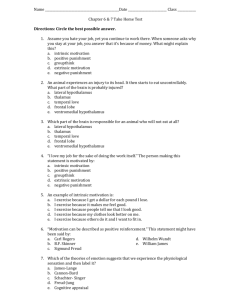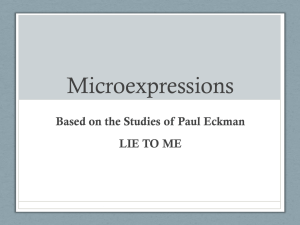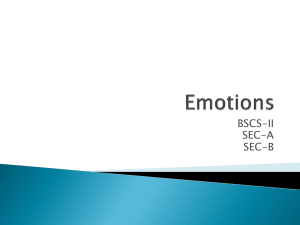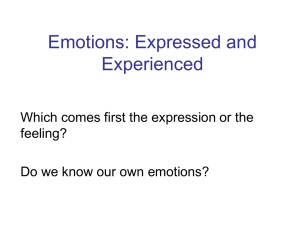Module 16 Presentation
advertisement
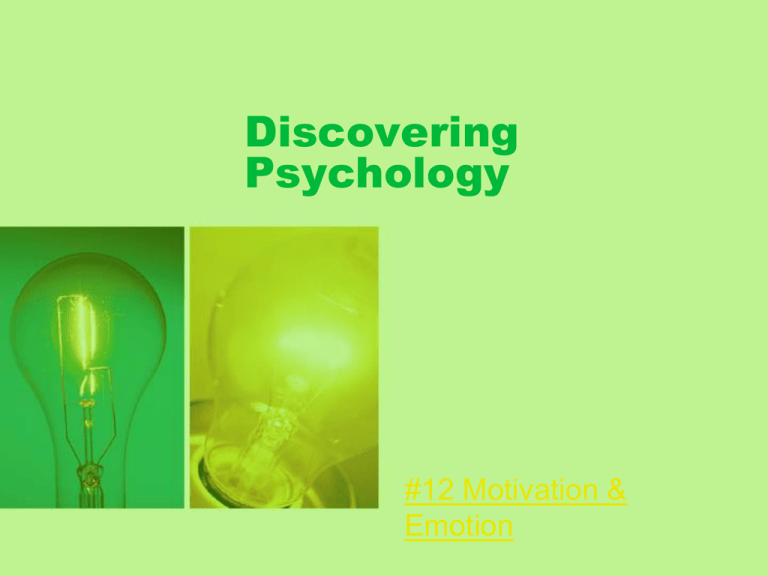
Discovering Psychology #12 Motivation & Emotion Facial Feedback/ James-Lange Demonstration/Experiment Module 16 Emotion Explaining Emotions 2 Types of Theories • Peripheral Theories – Physiological changes in the body give rise to your emotional feelings • James-Lange Theory • Facial Feedback Theory • Cognitive Theories – Your interpretations/appraisals of situations give rise to your emotional feelings • Schachter-Singer Experiment James-Lange Theory • Our brains interpret specific physiological changes as feelings or emotions • A different physiological pattern underlies each emotion 4 Steps • Physiological Changes – Site of an approaching shark triggers physiological changes • increasing heart rate & blood pressure • secretion of various hormones • Interpretation of Changes – Brain analyzes pattern of physiological change & interprets each pattern as a different emotion • Emotional Feeling – Different physiological changes produce different emotions • You may or may not show an observable response – Scream 3 Criticisms of JamesLange Theory • Different emotions are not necessarily associated with different physiological response patterns – Anger, fear & sadness share similar physiological patterns • People whose spinal cords have been severed at the neck still experience emotions • Some complex emotions (e.g., guilt, jealousy) may require a considerable interpretation/appraisal of the situation Facial Feedback Theory • Sensations/feedback from movement of facial muscles & skin are interpreted by the brain as different emotions • 4 Steps – – – – Stimulus triggers changes in facial muscles & skin Brain interprets feedback from facial muscles & skin Different facial feedback results in different emotions You may or may not show an observable response Criticisms of Facial Feedback Theory • Emotions can also be felt without any facial feedback – People whose facial muscles are completely paralyzed still experience emotions • Mood & Intensity – Feedback from facial muscles may intensify your emotional feeling Psych Sim Expressing Emotions Universal Emotions Interactivity Schachter-Singer Experiment • Physiological Arousal – Injected subjects with epinephrine that caused physiological arousal • Subjects were placed into 1 of 2 conditions – Happy Situation • Confederate was laughing & throwing paper airplanes – Angry Situation • Confederate complained about filling out a long questionnaire • Results: – Participants in happy situation often reported feeling happy – Observable behaviors = smiles – Participants in angry situation often reported feeling angry – Observable behaviors = angry facial expressions Schachter’s TwoFactors • The Two Factor Theory of Emotion: views emotion as having two components (factors): physiological arousal and cognition. According to the theory, cognitions are used to interpret the meaning of physiological reactions to outside events. Which Comes First: Feeling or Thinking? • Cognitive-Appraisal Theory – You think before you feel – Example: wining the lottery • Affective-Primacy Theory – In some situations, you feel an emotion before having time to interpret/appraise the situation – Example: seeing a snake Universal Emotional Expressions • Refer to a number of specific inherited facial patterns or expressions that signal specific feelings – Example: A smile signals a happy state • Cross-Cultural Evidence • Genetic Evidence Cross-Cultural Evidence – Recognition of facial expressions in different cultures suggests that there are innate universal facial expressions – Examples: happiness, fear, surprise Genetic Evidence • Infants in all cultures develop facial expressions at about the same age • At 4-6 weeks, babies smile • At 3-4 months, babies show angry & sad facial expressions • At 5-7 months, babies show fear Functions of Emotions • Send social signals – Facial expressions communicate your personal feelings • Help you adapt & survive – Psychoevolutionary theory of emotions • We inherit the neural structure & physiology to express & experience emotions • Emotional patterns evolved to help us adapt to our environment & promote survival • Arouse & motivate behaviors – Yerkes-Dodson law • Task performance is an interaction between physiological arousal and task difficulty – For most tasks, moderate arousal helps performance Can Money Buy Happiness? • Adaptation Level Theory – When we experience a good fortune, we quickly become accustomed to it – The initial impact fades & contributes less to long-term level happiness – Therefore, money can’t buy happiness because we adapt to the continuous satisfaction of having a lot of money Influences on Long-Term Happiness • Genetic Factors – About half your level of happiness comes from genetic influences • Identical twins reared together or apart showed sig. higher happiness correlations (.44 to .52) than fraternal twins reared together or apart (-.02 to .08) • Personal/Environmental factors – Long-term level of happiness is associated with: • enjoying simple daily pleasures • setting & achieving personal goals (purpose in life, network of friends) Psych Sim Helplessly Hoping & Optimism Showing Emotions: Why Don’t Men Cry? • Display Rules – Specific cultural norms that regulate how, when & where we should express emotion and how much emotion is appropriate – Example: • Japanese & Chinese have more difficulty identifying facial expressions of fear and anger compared to North Americans What is Emotional Intelligence? • Ability to perceive and express emotion, understand and reason with emotion and regulate emotions in one’s self and others • Researchers are in the early stages of trying to define & measure emotional intelligence Lie Detection • Polygraph tests are based on the theory that if a person tells a lie he/she will feel some emotion that can be measured • Polygraph – Lie detector that measures: • chest & abdominal muscle movement during respiration • heart rate • blood pressure • galvanic skin response (GSR) • GSR – Changes in sweating of the fingers or palms that accompany emotional experiences Lie Detection Control Question Technique • Lie detection technique in which the examiner asks 2 kinds of questions: – Neutral Questions • general questions that elicit little emotional response • “Is your name Floyd?” – Critical Questions • specific questions about some particular crime that only the criminal would know • “Did you rob the liquor store on 5th and Vine?” • Examiner compares differences in physiological responses between neutral & critical questions How Accurate are Lie Detector Tests? • Researchers have been unable to identify a physiological response pattern that is specific to lying • It is estimated that lie detector tests are wrong 25-75% of the time • Most state & federal courts prohibit the use of polygraph evidence • Federal law prohibits most employers from using polygraph tests to screen employees Emotional Intelligence Test Intrapersonal Activity Positive Psychology APA Unit Plan



